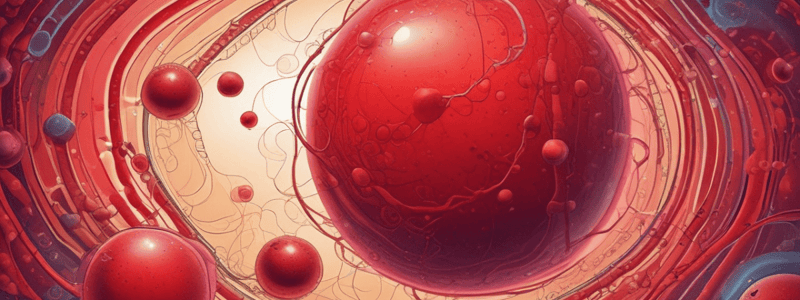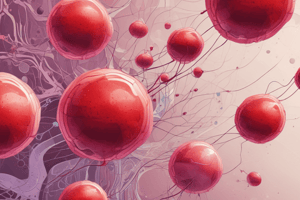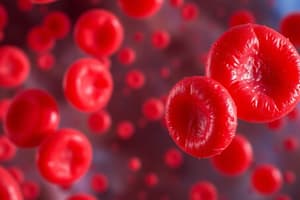Podcast
Questions and Answers
What is the function of antibodies in the human body?
What is the function of antibodies in the human body?
- To produce hormones
- To mark foreign substances for destruction (correct)
- To fight against the body's own cells
- To repair damaged tissues
Why can't someone with type A blood receive blood from someone with type AB blood?
Why can't someone with type A blood receive blood from someone with type AB blood?
- Because their body will produce more antibodies
- Because their body will attack the donated blood (correct)
- Because the donated blood is not compatible with their blood type
- Because their body is allergic to the donated blood
What would happen if someone with type O blood received blood from someone with type AB blood?
What would happen if someone with type O blood received blood from someone with type AB blood?
- Their body would produce more antibodies
- Their body would become immune to the donated blood
- Their body would attack the donated blood (correct)
- Their body would accept the donated blood
Why does the body not produce antibodies against its own cells?
Why does the body not produce antibodies against its own cells?
What is the name of the blood type that has no A or B molecules on the surface of the red blood cells?
What is the name of the blood type that has no A or B molecules on the surface of the red blood cells?
What is the reason someone with AB blood can receive blood from someone with A blood?
What is the reason someone with AB blood can receive blood from someone with A blood?
What would happen if someone with type AB blood received blood from someone with type O blood?
What would happen if someone with type AB blood received blood from someone with type O blood?
Which blood type is considered the universal donor?
Which blood type is considered the universal donor?
What is the purpose of the antibody-antigen reaction?
What is the purpose of the antibody-antigen reaction?
Who can receive blood from someone with O blood?
Who can receive blood from someone with O blood?
Why is it important to match the blood type of the donor and recipient during a transfusion?
Why is it important to match the blood type of the donor and recipient during a transfusion?
What would happen if someone with type B blood received blood from someone with type A blood?
What would happen if someone with type B blood received blood from someone with type A blood?
Why can't someone with B blood receive blood from someone with AB blood?
Why can't someone with B blood receive blood from someone with AB blood?
Why is it bad if the recipient's body attacks the donated blood during a transfusion?
Why is it bad if the recipient's body attacks the donated blood during a transfusion?
What is true about someone with O blood?
What is true about someone with O blood?
What is the term for someone who can receive blood from everyone?
What is the term for someone who can receive blood from everyone?
What is the primary component of a cell membrane?
What is the primary component of a cell membrane?
What are the A and B molecules that are embedded in the lipids of a red blood cell membrane?
What are the A and B molecules that are embedded in the lipids of a red blood cell membrane?
Why are the A and B groups important in medicine?
Why are the A and B groups important in medicine?
What is the term for the process of pumping blood into a patient's veins?
What is the term for the process of pumping blood into a patient's veins?
What is a characteristic of glycolipids?
What is a characteristic of glycolipids?
What can happen if you receive blood from someone with a different A or B group?
What can happen if you receive blood from someone with a different A or B group?
What is a possible combination of A and B groups that a person can have?
What is a possible combination of A and B groups that a person can have?
Why can't you give any blood to anyone?
Why can't you give any blood to anyone?
Flashcards are hidden until you start studying
Study Notes
Red Blood Cell Structure
- The outer layer of a red blood cell is made up of a cell membrane, which is composed of lipids and embedded proteins and molecules.
- The proteins and molecules embedded in the lipids have different functions, with two types being particularly important: A and B molecules.
A and B Molecules
- A and B molecules are not proteins, but rather glycolipids, a combination of sugar and fat groups.
- Not all people have both A and B molecules on their red blood cells; some may have only one, or neither.
Blood Transfusions
- In medicine, blood transfusions are often necessary, but it's not possible to give just any blood to anyone.
- The presence of A and B molecules on red blood cells determines the compatibility of blood transfusions.
Immune System Response
- The immune system uses antibodies to fight foreign substances in the body.
- Antibodies are produced against substances that are not part of the body, and the body is careful not to make antibodies against itself.
- People with A or B molecules on their red blood cells will produce antibodies against the corresponding molecule if it's not present on their own cells.
Blood Types and Compatibility
- There are four main blood types: A, B, AB, and O.
- Each blood type has specific combinations of A and B molecules on their red blood cells:
- A: only A molecules
- B: only B molecules
- AB: both A and B molecules
- O: neither A nor B molecules
- The compatibility of blood transfusions depends on the blood type of the donor and recipient:
- A recipient cannot receive blood from an AB donor.
- AB recipient can receive blood from A, B, or O donors.
- O donor can give blood to anyone, making them the universal donor.
- AB recipient can receive blood from anyone, making them the universal recipient.
Importance of Blood Type
- Knowing one's blood type is important in case of a blood transfusion, as it determines the compatibility of the blood received.
Studying That Suits You
Use AI to generate personalized quizzes and flashcards to suit your learning preferences.




